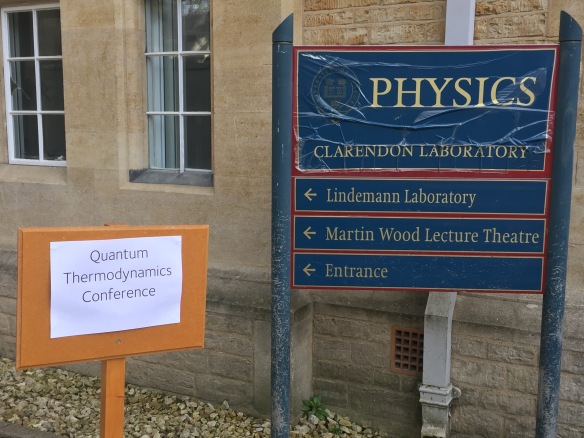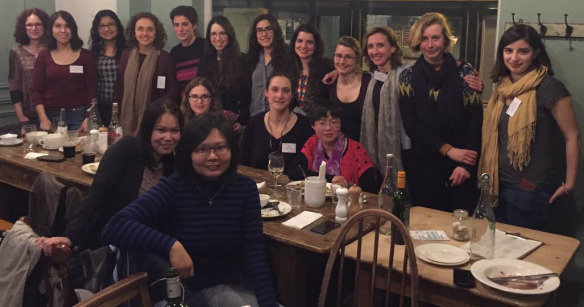You have four hours to tour Oxford University.
What will you visit? The Ashmolean Museum, home to da Vinci drawings, samurai armor, and Egyptian mummies? The Bodleian, one of Europe’s oldest libraries? Turf Tavern, where former president Bill Clinton reportedly “didn’t inhale” marijuana?
Felix Binder showed us a cemetery.
Of course he showed us a cemetery. We were at a thermodynamics conference.
The Fifth Quantum Thermodynamics Conference took place in the City of Dreaming Spires.1 Participants enthused about energy, information, engines, and the flow of time. About 160 scientists attended—roughly 60 more than attended the first conference, co-organizer Janet Anders estimated.

Weak measurements and quasiprobability distributions were trending. The news delighted me, Quantum Frontiers regulars won’t be surprised to hear.
Measurements disturb quantum systems, as early-20th-century physicist Werner Heisenberg intuited. Measure a system’s position strongly, and you forfeit your ability to predict the outcomes of future momentum measurements. Weak measurements don’t disturb the system much. In exchange, weak measurements provide little information about the system. But you can recoup information by performing a weak measurement in each of many trials, then processing the outcomes.
Strong measurements lead to probability distributions: Imagine preparing a particle in some quantum state, then measuring its position strongly, in each of many trials. From the outcomes, you can infer a probability distribution , wherein
denotes the probability that the next trial will yield position
.
Weak measurements lead analogously to quasiprobability distributions. Quasiprobabilities resemble probabilities but can misbehave: Probabilities are real numbers no less than zero. Quasiprobabilities can dip below zero and can assume nonreal values.

What relevance have weak measurements and quasiprobabilities to quantum thermodynamics? Thermodynamics involves work and heat. Work is energy harnessed to perform useful tasks, like propelling a train from London to Oxford. Heat is energy that jiggles systems randomly.
Quantum properties obscure the line between work and heat. (Here’s an illustration for experts: Consider an isolated quantum, such as a spin chain. Let denote the Hamiltonian that evolves with the time
. Consider preparing the system in an energy eigenstate
. This state has zero diagonal entropy: Measuring the energy yields
deterministically. Considering tuning
, as by changing a magnetic field. This change constitutes work, we learn in electrodynamics class. But if
changes quickly, the state can acquire weight on multiple energy eigenstates. The diagonal entropy rises. The system’s energetics have gained an unreliability characteristic of heat absorption. But the system has remained isolated from any heat bath. Work mimics heat.)
Quantum thermodynamicists have defined work in terms of a two-point measurement scheme: Initialize the quantum system, such as by letting heat flow between the system and a giant, fixed-temperature heat reservoir until the system equilibrates. Measure the system’s energy strongly, and call the outcome . Isolate the system from the reservoir. Tune the Hamiltonian, performing the quantum equivalent of propelling the London train up a hill. Measure the energy, and call the outcome
.
Any change in a system’s energy comes from heat
and/or from work
, by the First Law of Thermodynamics,
Our system hasn’t exchanged energy with any heat reservoir between the measurements. So the energy change consists of work:
.

Imagine performing this protocol in each of many trials. Different trials will require different amounts of work. Upon recording the amounts, you can infer a distribution
.
denotes the probability that the next trial will require an amount
of work.
Measuring the system’s energy disturbs the system, squashing some of its quantum properties. (The measurement eliminates coherences, relative to the energy eigenbasis, from the state.) Quantum properties star in quantum thermodynamics. So the two-point measurement scheme doesn’t satisfy everyone.
Enter weak measurements. They can provide information about the system’s energy without disturbing the system much. Work probability distributions give way to quasiprobability distributions
.
So propose Solinas and Gasparinetti, in these papers. Other quantum thermodynamicists apply weak measurements and quasiprobabilities differently.2 I proposed applying them to characterize chaos, and the scrambling of quantum information in many-body systems, at the conference.3 Feel free to add your favorite applications to the “comments” section.

All the quantum ladies: The conference’s female participants gathered for dinner one conference night.
Wednesday afforded an afternoon for touring. Participants congregated at the college of conference co-organizer Felix Binder.3 His tour evoked, for me, the ghosts of thermo conferences past: One conference, at the University of Cambridge, had brought me to the grave of thermodynamicist Arthur Eddington. Another conference, about entropies in information theory, had convened near Canada’s Banff Cemetery. Felix’s tour began with St. Edmund Hall’s cemetery. Thermodynamics highlights equilibrium, a state in which large-scale properties—like temperature and pressure—remain constant. Some things never change.

With thanks to Felix, Janet, and the other coordinators for organizing the conference.
1Oxford derives its nickname from an elegy by Matthew Arnold. Happy National Poetry Month!
2https://arxiv.org/abs/1508.00438, https://arxiv.org/abs/1610.04285,
https://arxiv.org/abs/1607.02404,
https://journals.aps.org/prl/abstract/10.1103/PhysRevLett.118.070601,
https://journals.aps.org/prl/abstract/10.1103/PhysRevLett.120.040602
3Michele Campisi joined me in introducing out-of-time-ordered correlators (OTOCs) into the quantum-thermo conference: He, with coauthor John Goold, combined OTOCs with the two-point measurement scheme.
3Oxford University contains 38 colleges, the epicenters of undergraduates’ social, dining, and housing experiences. Graduate students and postdoctoral scholars affiliate with colleges, and senior fellows—faculty members—govern the colleges.

With 4 hours to visit Oxford, I sure hope that included G & D’s ice cream! 🙂
Also, I’m biased, but Somerville College and the Mathematical Institute are great places to visit. 😉
Whenever I had visitors, walking up to the top of a tall building (e.g., St. Mary’s the Virgin church, or in Magdelen College, if you can get someone there to take you) to see a high-up view of the city was the most standard thing I would try to do with them.
St. Mary’s is one of my favorite spots! I used a later meal with a friend as an excuse to visit G&D’s. 🙂
Pingback: Long live Yale’s cemetery | Quantum Frontiers
Pingback: Love in the time of thermo | Quantum Frontiers
Pingback: May I have this dance? | Quantum Frontiers